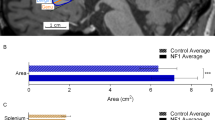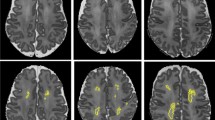Abstract
Introduction
To study the relationships between midbrain morphology, Loes score, gross motor function, and cognitive function in infantile Krabbe disease.
Methods
Magnetic resonance imaging (MRI) scans were evaluated by two neuroradiologists blinded to clinical status and neurodevelopmental function of children with early or late infantile Krabbe disease. A simplified qualitative 3-point scoring system based on midbrain morphology on midsagittal MRI was used. A score of 0 represented normal convex morphology of the midbrain, a score of 1 represented flattening of the midbrain, and a score of 3 represented concave morphology of the midbrain (hummingbird sign). Spearman correlations were estimated between this simplified MRI scoring system and the Loes score, gross motor score, and cognitive score.
Results
Forty-two MRIs of 27 subjects were reviewed. Analysis of the 42 scans showed normal midbrain morphology in 3 (7.1 %) scans, midbrain flattening in 11 (26.2 %) scans, and concave midbrain morphology (hummingbird sign) in 28 (66.7 %) scans. Midbrain morphology scores were positively correlated with the Loes score (r = 0.81, p < 0.001) and negatively correlated with both gross motor and cognitive scores (r = −.84, p < 0.001; r = −0.87, p < 0.001, respectively). The inter-rater reliability for the midbrain morphology scale was κ = .95 (95 % CI: 0.86–1.0), and the inter-rater reliability for the Loes scale was κ = .58 (95 % CI: 0.42–0.73).
Conclusions
Midbrain morphology scores of midsagittal MRI images correlates with cognition and gross motor function in children with Krabbe disease. This MRI scoring system represents a simple but reliable method to assess disease progression in patients with infantile Krabbe disease.




Similar content being viewed by others
References
Suzuki K (2003) Globoid cell leukodystrophy (Krabbe’s disease): update. J Child Neurol 18:595–603
Escolar ML, Poe MD, Provenzale JM et al (2005) Transplantation of umbilical-cord blood in babies with infantile Krabbe’s disease. N Engl J Med 352:2069–2081. doi:10.1056/NEJMoa042604
Loes DJ, Hite S, Moser H et al (1994) Adrenoleukodystrophy: a scoring method for brain MR observations. AJNR Am J Neuroradiol 15:1761–1766
Barkovich AJ, Ferriero DM, Bass N, Boyer R (1997) Involvement of the pontomedullary corticospinal tracts: a useful finding in the diagnosis of X-linked adrenoleukodystrophy. Am J Neuroradiol 18:95–100
Hattingen E, Blasel S, Nichtweiss M et al (2010) MR imaging of midbrain pathologies. Clin Neuroradiol 20:81–97. doi:10.1007/s00062-010-0009-6
Escolar ML, Poe MD, Smith JK et al (2009) Diffusion tensor imaging detects abnormalities in the corticospinal tracts of neonates with infantile krabbe disease. Am J Neuroradiol 30:1017–1021. doi:10.3174/ajnr.A1476
Iwata M (1998) Neuroimaging of motor disturbances. Rinshō Shinkeigaku Clin Neurol 38:1010–1012
Kato N, Arai K, Hattori T (2003) Study of the rostral midbrain atrophy in progressive supranuclear palsy. J Neurol Sci 210:57–60
Aiba I, Hashizume Y, Yoshida M et al (1997) Relationship between brainstem MRI and pathological findings in progressive supranuclear palsy—study in autopsy cases. J Neurol Sci 152:210–217
Oba H, Yagishita A, Terada H et al (2005) New and reliable MRI diagnosis for progressive supranuclear palsy. Neurology 64:2050–2055. doi:10.1212/01.WNL.0000165960.04422.D0
Loes DJ, Peters C, Krivit W (1999) Globoid cell leukodystrophy: distinguishing early-onset from late-onset disease using a brain MR imaging scoring method. AJNR Am J Neuroradiol 20:316–323
Martin HR, Poe MD, Reinhartsen D et al (2008) Methods for assessing neurodevelopment in lysosomal storage diseases and related disorders: a multidisciplinary perspective. Acta Paediatr Oslo Nor 1992(Suppl 97):69–75. doi:10.1111/j.1651-2227.2008.00651.x
Mullen EM (1995) Mullen scales of early learning. Circle Pines, MN: American Guidance Service. Inc. (21)
Folio M, Fewell R (2000) Peabody developmental motor scales, 2nd edn. Pro-Ed, Austin
Cohen J (1960) A coefficient of agreement for nominal scales. Educ Psychol Meas 20:37–46. doi:10.1177/001316446002000104
Cicchetti DV, Allison T. New procedure for assessing reliability of scoring EEG sleep recordings. Am J EEG Technol 11:101–109
Littel R, Milliken G, Stroup W, Wolfinger R (2006) SAS System for Mixed Models, 2nd edn. SAS Institute, Cary
Kenward MG, Roger JH (1997) Small sample inference for fixed effects from restricted maximum likelihood. Biometrics 53:983–997
Jones BV, Barron TF, Towfighi J (1999) Optic nerve enlargement in Krabbe’s disease. AJNR Am J Neuroradiol 20:1228–1231
Functional Neuroanatomy: Text and Atlas by Adel K. Afifi, Ronald A. Bergman: McGraw-Hill Professional 9780070015890 1st Edition—Better World Books. http://www.abebooks.com/servlet/BookDetailsPL?bi=13246757564&searchurl=sortby%3D20%26isbn%3D0070015899. Accessed 15 Mar 2015
Ruchalski K, Hathout GM (2012) A medley of midbrain maladies: a brief review of midbrain anatomy and syndromology for radiologists. Radiol Res Pract 2012:e258524. doi:10.1155/2012/258524
Righini A, Antonini A, Notaris RD et al (2004) MR imaging of the superior profile of the midbrain: differential diagnosis between progressive supranuclear palsy and parkinson disease. Am J Neuroradiol 25:927–932
Conforti L, Gilley J, Coleman MP (2014) Wallerian degeneration: an emerging axon death pathway linking injury and disease. Nat Rev Neurosci 15:394–409. doi:10.1038/nrn3680
Teixeira CA, Miranda CO, Sousa VF et al (2014) Early axonal loss accompanied by impaired endocytosis, abnormal axonal transport, and decreased microtubule stability occur in the model of Krabbe’s disease. Neurobiol Dis 66:92–103. doi:10.1016/j.nbd.2014.02.012
Loes DJ, Fatemi A, Melhem ER et al (2003) Analysis of MRI patterns aids prediction of progression in X-linked adrenoleukodystrophy. Neurology 61:369–374
Krivit W, Shapiro EG, Peters C et al (1998) Hematopoietic stem-cell transplantation in globoid-cell leukodystrophy. N Engl J Med 338:1119–1126. doi:10.1056/NEJM199804163381605
Provenzale JM, Peddi S, Kurtzberg J et al (2009) Correlation of neurodevelopmental features and MRI findings in infantile Krabbe’s disease. AJR Am J Roentgenol 192:59–65. doi:10.2214/ajr.192.5_supplement.0a59
Acknowledgments
We acknowledge NIH/NINDS R01 NS061965-01, the DANA foundation and The Legacy of Angels Foundation.
Ethical standards and patient consent
We declare that all human and animal studies have been approved by the UPMC IRB and have therefore been performed in accordance with the ethical standards laid down in the 1964 Declaration of Helsinki and its later amendments. We declare that all patients gave informed consent prior to inclusion in this study.
Conflict of interest
We declare that we have no conflict of interest.
Author information
Authors and Affiliations
Corresponding author
Rights and permissions
About this article
Cite this article
Zuccoli, G., Narayanan, S., Panigrahy, A. et al. Midbrain morphology reflects extent of brain damage in Krabbe disease. Neuroradiology 57, 739–745 (2015). https://doi.org/10.1007/s00234-015-1523-7
Received:
Accepted:
Published:
Issue Date:
DOI: https://doi.org/10.1007/s00234-015-1523-7




